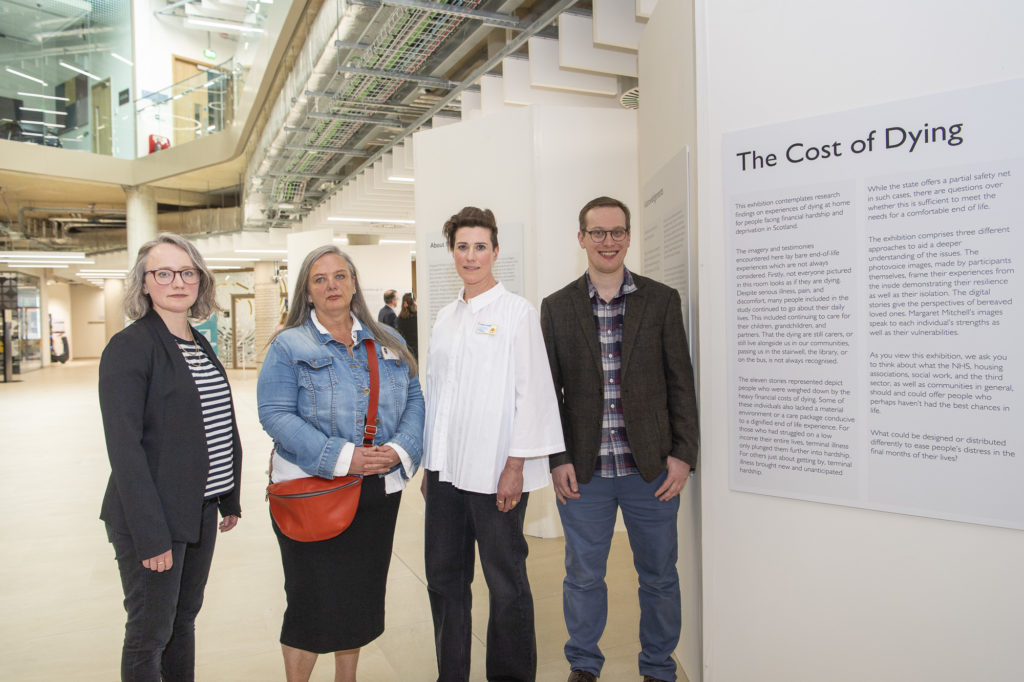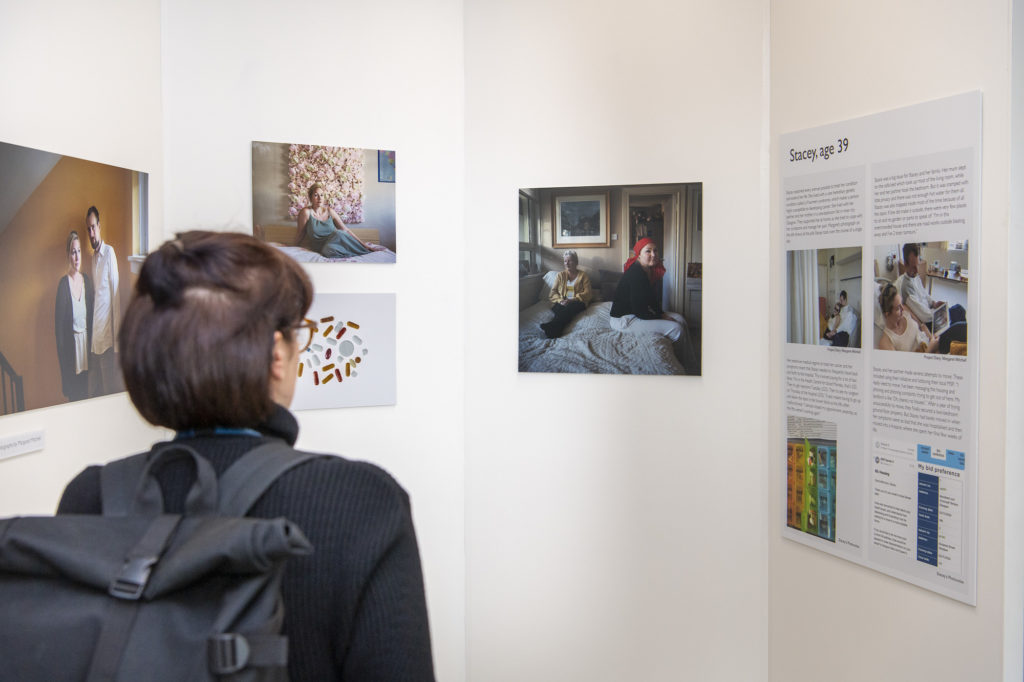
The Dying in the Margins study, a project exploring the way socio-economic circumstances intersect with end-of-life experiences, culminated in a large public exhibition, The Cost of Dying, held at the Advanced Research Centre at The University of Glasgow (25 April – 5 May 2023). Over the ten days the exhibition ran, we received an overwhelming response. More than 1000 people visited and we were able to collect written feedback and have countless thought-provoking conversations.
The exhibition presented the stories of people with lived experience of financial hardship at the end of life through a combination of participants’ photographs, digital stories by bereaved relatives and professional images taken by renowned Scottish photographer, Margaret Mitchell. The BBC covered the exhibition through TV, radio and online channels which increased footfall to the exhibition.
The responses to the exhibition were as diverse as they were moving. While some attendees found the stories upsetting, there was also a strong undercurrent of anger: “We are not equal even in death. Inequality is killing us. It is so important that issues like this are brought to light.”
Some shared their own stories and commented that the exhibition had helped to affirm their experiences:
“My mother-in-law spent the final 3 years of her life in a care home, due to financial hardship and inadequate housing to meet her needs. When she died there was no money to pay for her funeral, from her own benefits, and due to the financial hardship faced by other family members. As a result of a lack of a financial safety net we could only afford a direct cremation with my father-in-law claiming help with funeral expenses from the DWP.”

A hugely important question asked by exhibition visitors was, “What next?” This question underlines the desire for tangible improvement, a call to action. While there is huge sadness in these stories, for me, the exhibition is not about lamenting the status quo, but to drive a conversation about necessary change.
In response to the “What next?” question, we have collaborated with colleagues at Marie Curie, the charity which supports people with terminal illness, to produce a briefing paper making a number of clear policy recommendations:
- Scottish and nation-wide governments to commit to financial support specifically for terminally ill people, their families and carers experiencing poverty and multiple disadvantages, accompanied by a parallel public awareness campaign to ensure uptake;
- Scottish Government’s upcoming palliative care strategy and National Care Service to apply an intersectional lens, which acknowledges the complex and intersecting nature of multiple disadvantage across a person’s life course, to ensure equity-informed end of life support;
- Scottish Government’s new Housing Standard and Scottish Accessible Homes Standard must reflect people living with multi-morbidity (at least one terminal condition) for both existing and new homes, and Scottish Government’s Housing Bill must strengthen the rights of terminally ill tenants, their families and carers;
- Local Government must commit to fast-tracking housing maintenance, adaptations, and moving requests for terminally ill people using the BASRiS form; Local Government and Housing Associations must extend eviction notices for bereaved co-inhabitants living in social housing for six months after the death;
- Ring fenced funding from Scottish Government, Local Government and Health Boards to double the recruitment of advocacy professionals such as community link workers, as called for by GPs at the Deep End, with a parallel training programme in social determinants of health to empower and equip staff;
- Local Government, public sector organisations and health and social care education providers to embed education on social determinants of health as a core aspect of curriculums, training and practice to build knowledge and confidence in trauma-informed practice for all professionals, including community link workers, as part of a continual professional development programme.
The next chance to see the Cost of Dying exhibition will be at the Mitchell Library in Glasgow (20th June – 19th August). Beyond that it will be shown to politicians and civil servants at the Scottish Parliament in Holyrood in November.
Our aim is to ensure that the stories and experiences evoked through the Cost of Dying exhibition, which have resonated with so many, continue to be used to raise awareness about the issue of financial hardship at the end of life, and to advocate for material change.


My friend and I found the Dying in the Margins Exhibition incredibly thought provoking and moving. Margaret’s photos were intrinsic to conveying the stories of these people. I feel very lucky that Sam and his wife just happened to be there during our visit and took time to give us more insight into the problems and stories involved. Thank you so much.